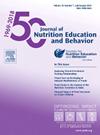A 5-Step Process Used to Develop a Gamified Curriculum for High Schoolers from Low-Income Communities: Rev It Up!
IF 2.3
3区 医学
Q2 EDUCATION, SCIENTIFIC DISCIPLINES
引用次数: 0
Abstract
Background
American high schoolers, especially those from low-income communities, exhibit poor adherence to nutrition and physical activity (PA) guidelines. Their average Healthy Eating Index score is 51/100, and only one-quarter report exercising for one hour each day. It could behoove nutrition educators to intervene with high schoolers before they become free-living adults, but there are few evidence-based interventions for this audience, indicating a need for intervention development.
Objective
Develop a nutrition and PA curriculum for high schoolers from low-income communities (Rev It Up!).
Study Design, Settings, Participants
A 5-step process (needs assessment, concept testing, developer and peer educator pilot testing, and impact evaluation) was implemented from 2014-2022 with high schoolers from New Jersey Title I schools participating in Supplemental Nutrition Assistance Program – Education or Expanded Food and Nutrition Education Program.
Measurable Outcome/Analysis
Feedback from observations, interviews, focus groups, and quantitative assessments informed iterative curriculum revisions throughout the process.
Results
The needs assessment identified key nutrition and PA behaviors to address with the intervention. Originally, a social marketing concept (MVPA, My Way!) was tested based on focus group feedback from the target audience, but the tested activities did not properly engage adolescents in a classroom environment. Eventually, the Rev It Up! curriculum, based on the Theory of Planned Behavior was developed using gamification and active learning approaches that received much more engagement. The developer and peer educator pilot testing identified time management and classroom management issues, respectively, with the lesson plans that were addressed by the development team. The impact evaluation indicated substantial behavioral improvement in 8 of 13 indicators after accounting for treatment effect heterogeneity.
Conclusions
Developing an evidence-based curriculum is a time-intensive process, but the utilization of a robust, iterative process like the one presented allows for a final curriculum that has high engagement and impact. Nutrition educators could adapt this model to develop evidence-based interventions in the future.
Funding
Rev It Up! was developed using resources from the NJ EFNEP and SNAP-Ed programs.
为低收入社区的高中学生开发游戏化课程的5个步骤:加快速度!
美国高中生,特别是来自低收入社区的高中生,对营养和体育活动(PA)指南的遵守程度较差。他们的平均健康饮食指数得分为51/100,只有四分之一的人每天锻炼一小时。在高中生成为自由生活的成年人之前,营养教育工作者应该对他们进行干预,但针对这一群体的循证干预很少,这表明干预发展的必要性。目的:为来自低收入社区的高中生开发营养和PA课程(Rev It Up!)研究设计、设置、参与者从2014年至2022年,在新泽西州一级学校参加补充营养援助计划-教育或扩展食品和营养教育计划的高中生中实施了一个五步过程(需求评估、概念测试、开发者和同伴教育者试点测试以及影响评估)。可测量的结果/分析来自观察、访谈、焦点小组和定量评估的反馈在整个过程中为反复的课程修订提供了信息。结果需求评估确定了干预需要解决的关键营养和PA行为。最初,一个社会营销概念(MVPA, My Way!)是基于目标受众的焦点小组反馈进行测试的,但是测试的活动并没有在课堂环境中适当地吸引青少年。最后,Rev It Up!基于计划行为理论的课程采用游戏化和主动学习方法开发,获得了更多的参与。开发人员和同伴教育者试点测试分别用开发团队处理的课程计划确定了时间管理和教室管理问题。在考虑到治疗效果的异质性后,影响评估显示13项指标中有8项行为有实质性改善。开发一个以证据为基础的课程是一个耗时的过程,但是使用一个健壮的、迭代的过程,就像上面展示的那样,可以使最终的课程具有很高的参与度和影响力。营养教育工作者可以调整这一模式,在未来发展以证据为基础的干预措施。融资,加快速度!是利用NJ EFNEP和SNAP-Ed项目的资源开发的。
本文章由计算机程序翻译,如有差异,请以英文原文为准。
求助全文
约1分钟内获得全文
求助全文
来源期刊
CiteScore
4.20
自引率
11.50%
发文量
379
审稿时长
44 days
期刊介绍:
The Journal of Nutrition Education and Behavior (JNEB), the official journal of the Society for Nutrition Education and Behavior, is a refereed, scientific periodical that serves as a global resource for all professionals with an interest in nutrition education; nutrition and physical activity behavior theories and intervention outcomes; complementary and alternative medicine related to nutrition behaviors; food environment; food, nutrition, and physical activity communication strategies including technology; nutrition-related economics; food safety education; and scholarship of learning related to these areas.
The purpose of JNEB is to document and disseminate original research and emerging issues and practices relevant to these areas worldwide. The Journal of Nutrition Education and Behavior welcomes evidence-based manuscripts that provide new insights and useful findings related to nutrition education research, practice and policy. The content areas of JNEB reflect the diverse interests in nutrition and physical activity related to public health, nutritional sciences, education, behavioral economics, family and consumer sciences, and eHealth, including the interests of community-based nutrition-practitioners. As the Society''s official journal, JNEB also includes policy statements, issue perspectives, position papers, and member communications.

 求助内容:
求助内容: 应助结果提醒方式:
应助结果提醒方式:


